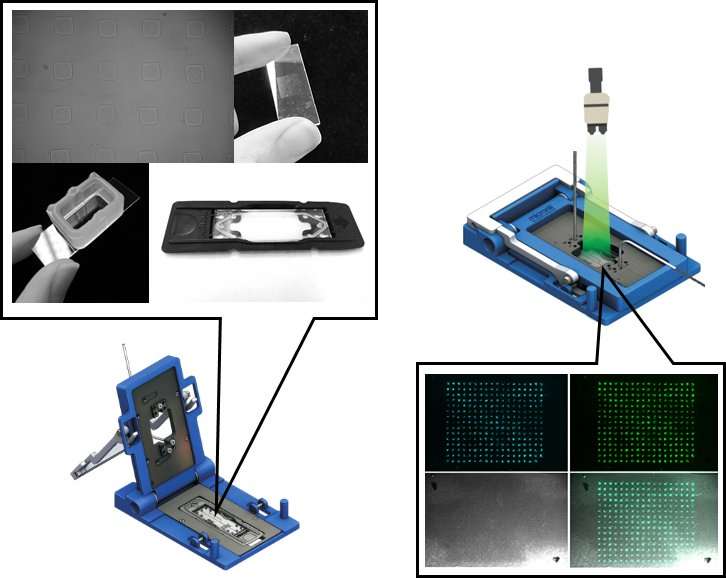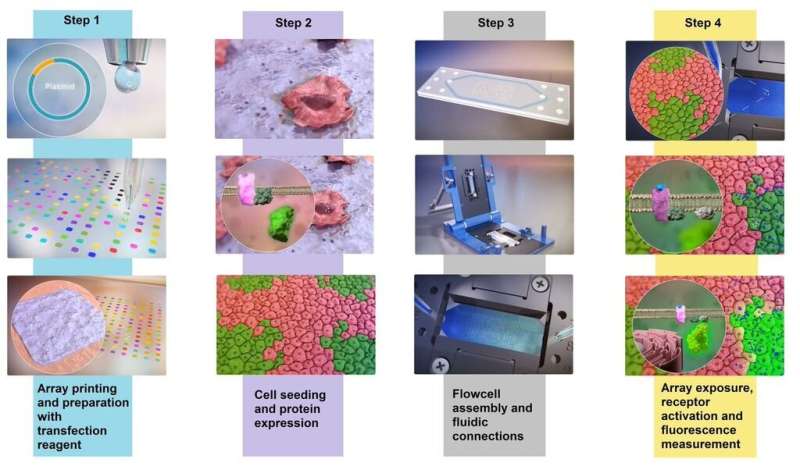New technique opens new research possibilities for novel drugs and tasty food

Scientists at Wageningen University have developed a new technique that opens new possibilities for research into novel drugs and tastier, healthier food. The new approach is called 'receptomics' and was published in the scientific journal Sensors. The technique measures the response of many different receptor proteins to series of extracts or pure substances in a flow cell, and predicts responses in the human body, thus reducing the need for test panels or animal experiments. The receptomics technique may also be useful for the development of personalised food and medication.
Our bodies contain a wide variety of receptors – proteins that detect substances and pass on signals to the cell to which they are linked. Humans have tongue and nasal receptors for detecting aromas and flavours, for example, but also receptors in the intestines for detecting hormones, which ensure that intestinal cells take the proper action, such as absorbing or digesting a certain nutrient from the intestine. All these receptor proteins are encoded by genes.
Microscopically small droplets
The Wageningen scientists 'printed' the DNA for many receptor proteins as miniscule droplets on glass slides, forming spots in a grid pattern covering approximately one square centimetre. In each DNA droplet, they also included DNA that codes for a coloured signaling protein that can visually report the response of the receptor protein.
Cells are grown on the glass slide on top of the DNA grid. The two types of DNA in each spot are absorbed into the cells. The cells use the DNA to make the receptor protein and the coloured signalling protein. This creates small groups of cells with the size of the DNA spots. Each group of cells produces a unique receptor protein and the coloured signalling protein.
The glass slide is then placed in a device that pumps a very thin layer of liquid across the slide. "This liquid may be an extract of a medicinal plant, or from a regular tomato or apple," says Maarten Jongsma, molecular biologist at Wageningen University & Research and coordinator of the research. "Some receptor proteins will react to the liquid that runs over the cells. Thanks to the coloured signalling protein, we can determine under a microscope which receptor proteins respond and which do not."
After each measurement, the cells are 'washed' by pumping a washing liquid across the cells to remove the trigger and return to normal. The cells are then ready for a new sample exposure. This way series of samples can be measured.
Smart mathematics
The final step in studying the responses of receptor protein is the use of smart and powerful statistics and software. Jongsma says, "These living cells often produce a variable and complex response to an extract that is a sum of everything in the extract, the amount of DNA that is being expressed and the nature of the host cell. This was why it was initially difficult to draw conclusions." Jongsma's research team, which includes cell biologists, molecular biologists, statisticians and software engineers, developed software that allows them to easily find this needle in the haystack.

With the receptomics technique, the scientists now have a powerful new tool which allows them to record responses to, say, foods or medicinal plants with a wide variety of receptor proteins and predict effects in humans.
The technique may also offer opportunities to provide more substantiated personal advice on nutrition and medication in the future. Jongsma: "Each person has a slightly different set of receptor proteins. By determining which types of receptor protein are on a patient's DNA and linking them to the receptomics analysis results, doctors may be able to give even more customised advice in the future."
More information: undefined undefined et al. Calcium Imaging of GPCR Activation Using Arrays of Reverse Transfected HEK293 Cells in a Microfluidic System, Sensors (2018). DOI: 10.3390/s18020602
Provided by Wageningen University



















